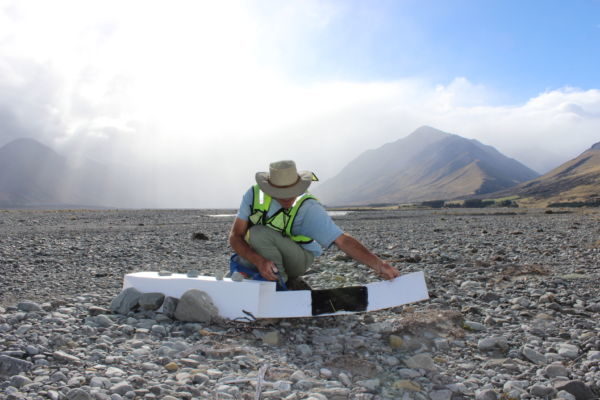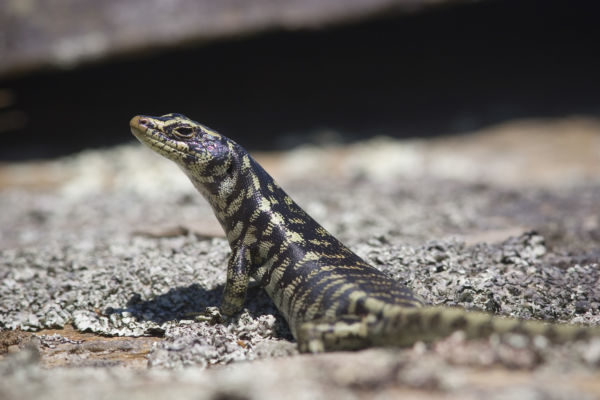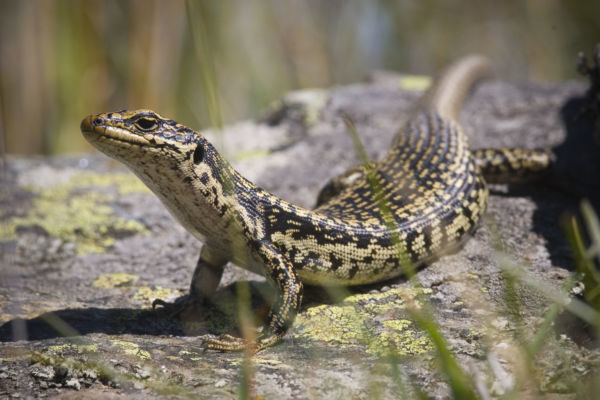A week or two ago, Alexandra-based Landcare Research scientist Grant Norbury found himself alone in the middle of the remote Mackenzie country, syringe in hand, squirting Vaseline onto rocks. He had to laugh.

“It’s such a weird way to protect dotterels,” he says.
Yes it is. But weirdness aside, the science behind his latest ‘chemical camouflage’ research project is fascinating. It’s all about making predators bored with birds, so that they stick to their normal prey like rabbits and mice.
“It’s messing with their mind,” says Grant, “playing with their psychology so that they think bird odours aren’t worth pursuing. It’s a niche method – potentially, a part of the predator control toolbox.”
It works like this. Before birds arrive to breed, bird scent is laid around the nesting habitat. Any predators present soon learn that the interesting odour doesn’t lead to a meal and lose interest in following the trail. When the real birds arrive, their scent is then ignored.

“We did pen trials at Lincoln with predators in pens. They became habituated to the odour and when we changed the bird odour there was still a lack of interest, although it was highly variable among individuals.”
The pen trials used ferrets and hedgehogs. The fact that they remained bored with a new bird odour, means that they are generalising ‘bird’ scent as boring. Thus a false chicken scent, for example, can potentially be used to protect dotterels, wrybills and black stilts, although their bird scent will be slightly different to chicken. The predators are reacting to ‘bird flavour’ not ‘chicken flavour’.
So what’s with the Vaseline?
To make the false bird scent, Landcare scientists extracted bird odour from chicken feathers (supplied by Tegal), commercial quail (whole bodies were used) and black-backed gulls (whole bodies). Although black-backed gulls are a native species, they are considered a pest and sometimes shot. The odours were extracted into a solvent, with the volatile solvent then removed. This leaves behind a mixture of bird odour compounds which are mixed with Vaseline, both to make the material easier to handle and to make it longer-lasting in the field.
“Then we walk around riverbeds etc, squirting blobs onto rocks,” says Grant. “There are treated and non-treated areas and we’ll compare banded dotterel nest survival.”
“It is,” Grant admits, “not a sustainable technique in its current form. It’s too labour intensive.”
He hopes that in the future, if the technique shows promise, the lures could be manufactured commercially and applied using drones. Phase 2 of the project would involve developing a method that could be used on a management scale. It’s ‘high-risk’ research, sponsored by the Government’s ‘Smart Ideas’ fund, but it’s based on a good understanding of predator behaviour.
“Introduced predators generally prey on introduced species,” says Grant. “Ferrets and cats mostly prey on rabbits. It’s generally a minority of rogue individuals that cause problems. A few specialists hunt secondary prey (native birds). The chemical camouflage technique deals with those problematic animals.”

The idea that there are a minority of ‘rogue individuals’ causing predation problems is backed up by previous research that Grant and his colleague, Chris Jones, have done, including ‘line and spool’ experiments using hedgehogs in a braided river habitat. A spool of thread was attached to each of the 10 hedgehogs used in the experiment and researchers then followed the threads to see where the hedgehogs were foraging. Nine of the hedgehogs foraged in the grassy, shrubby margins of the riverbeds looking for their normal prey of beetles and other invertebrates. Only one female foraged on the river braids where endangered birds were nesting. Hedgehogs, along with cats and mustelids, have been regularly captured on film predating birds’ nests.
Based in the Alexandra office of Landcare Research, Grant’s various research projects have a common theme of dry grassland ecology. It’s a habitat where rabbits very much drive predator populations. Rabbit numbers, in turn, are determined by soil, climate and vegetation. As a keystone species, rabbits not only drive predator numbers, but they are also changing the habitat and that has important consequences for another of Grant’s research and personal interests: our native lizards.
“Native bird fauna is fairly depleted in dryland. There are a lot of exotic (bird) species. But some lizard species, although depleted in many areas, are abundant in warm, open, sunny landscapes.”
Grant volunteers his time with the Central Otago Ecological Trust, who have built a fenced sanctuary near Alexandra where rare native skinks are being translocated. It’s home to both Grand Skinks and Otago Skinks currently, but other species, including weta, may also be translocated there in the future.
The sanctuary ties in with another of Grant’s ecological research projects – this time near the Macraes goldmining area where there are also fenced reserves where Grand and Otago skinks are recovering very well. Research carried out by DOC on the skink populations both inside and outside the fences at Macraes showed that the skinks are also recovering very well outside the fenced reserve, where there is extensive predator control. Although bigger predators were being dealt to, mice are uncontrolled outside the fences but both Grand and Otago skinks are large – the mice didn’t seem to be affecting them. Did this mean that mice weren’t a problem for these large skinks?

Macraes is a native tussock grassland – a much tougher grassland system than introduced grassland habitats. Mice are generally rare at Macraes, but numbers explode when the tussock masts. It’s a boom and bust system and, it was subsequently realised, mice could became a problem for the skinks when they reached acute peak numbers, but the skinks are doing okay at Macraes despite these acute peaks.
In contrast, the grasslands around Alexandra are exotic species bred specifically to be high yielding. They effectively ‘mast’ every year and mouse numbers consequently remain much higher and more constant there than in the native tussock habitat of Macraes. In this high-yield grassland, mice are super-abundant and do have an impact on the big lizards. Hence, the need for the Central Otago Ecological Trust’s fenced sanctuary that also excludes mice.
Through the research of Grant and others, predator-prey relationships in dry grassland ecosystems are becoming better understood. Much has been learnt about skinks, for example.
“We don’t know so much about invertebrates,” Grant says. “There’s the robust grasshopper in the Mackenzie, the Cromwell chafer beetle, various weta…”
There are a few native passerine birds in the dry grassland ecosystems Grant studies, and there are several highly threatened wading species breeding on the regions open braided rivers.
“You get hyperpredation,” Grant explains. “Where there are rabbits, there are lots of predators. Although individually, the predators aren’t eating a lot of secondary prey species, there are so many predators that the numbers soon stack up.”
The numbers add up to significant predation. But hopefully this year, those rogue ‘problem’ individuals will have tired of following enticing, but ultimately unrewarding chicken, quail and gull scent trails and will have returned to hunting rabbits by the time the dotterels and wrybills arrive to nest.

